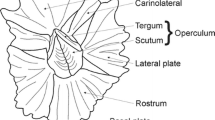Abstract
Barnacles [Balanus balanoides (L.), Elminius modestus Darwin, Lepas anatifera (L.)] from several different sites were found to accumulate the heavy metal zinc. The majority of the zinc was deposited in the tissues associated with the gut, and the level of zinc in soft body tissue generally reflected well the level of zinc in the immediate sea-water environment. The zinc accumulated in the gut tissues was in the form of discrete granules, mainly within the parenchyma cells which surround the gut. These granules probably exist as an insoluble zinc salt. A comparison of the zinc level in barnacles with those recorded for some other marine organisms indicates the possible usefulness of barnacles as indicators of zinc pollution.
Similar content being viewed by others
Literature cited
Abdullah, M.I., L.G. Royle and A.W. Morris: Heavy metal concentration in coastal waters. Nature, Lond. 235, 158–160 (1972)
Atkins, W.R.G.: The estimation of zinc in sea water using sodium diethyl dithiocarbamate. J. mar. biol. Ass. U.K. 20, 625–626 (1936). (Quoted after Sverdrup et al., 1949)
Bourget, E.: Environmental and structural control of trace elements in barnacle shells. Mar. Biol. 28, 27–36 (1974)
Brewer, P.G., D.W. Spencer and D.E. Robertson: Trace element profiles from the Geosecs-II test station in the Sargasso Sea. Earth planet. Sci. Letters 16, 111–116 (1972)
Bruntz, L.: L'excrétion chez les cirripèdes. C.r. hebd. Séanc. Acad. Sci., Paris 135, 987–988 (1902)
Bryan, G.W.: Concentrations of zinc and copper in the tissues of decapod crustaceans. J. mar. biol. Ass. U.K. 48, 303–321 (1968)
—: The absorption of zinc and other metals by the brown seaweed Laminaria digitata. J. mar. biol. Ass. U.K. 49, 225–243 (1969)
—: The occurrence and seasonal variation of trace metals in the scallops Pecten maximus (L.) and Chlamys opercularis (L.). J. mar. biol. Ass. U.K. 53, 145–166 (1973)
— and L.G. Hummerstone: Brown seaweed as an indicator of heavy metals in estuaries in South-west England. J. mar. biol. Ass. U.K. 53, 705–720 (1973a)
——: Adaptation of the polychaete Nereis diversicolor to estuarine sediments containing high concentrations of zinc and cadmium. J. mar. biol. Ass. U.K. 53, 839–857 (1973b)
Darwin, C.: A monograph of the sub-class Cirripedia. The Balanidae, the Verrucidae, etc., p. 86. London: Ray Society 1854
Elderfield, H., L. Thornton and J.S. Webb: Heavy metals and oyster culture in Wales. Mar. Pollut. Bull. 2 (3), 44–47 (1971)
Foster, B.A.: Responses and acclimation to salinity in the adults of some balanomorph barnacles. Phil. Trans. R.Soc. (Ser. B). 256, 377–400 (1970)
Humbert, W.: Localisation, structure et genèse des concrétions minérales dans le mésentéron des collemboles Tomoceridae (Insecta, Collembola). Z. Morph. Tiere 78, 93–109 (1974)
Ireland, M.P.: Result of fluvial zinc pollution on the zinc content of littoral and sublittoral organisms in Cardigan Bay, Wales. Envir. Pollut. 4, 27–35 (1973)
—: Variations in the zinc, copper, manganese and lead content of Balanus balanoides in Cardigan Bay, Wales. Envir. Pollut. 7, 65–75 (1974)
Koulish, S.: Fine structure at the basal surface of intestinal epithelium in the midgut region of the Balanidae, with special reference to ‘neural-like’ processes. J. Morph. 135, 1–12 (1971)
Morris, A.W.: Seasonal variation of dissolved metals in inshore waters of the Menai Straits. Mar. Pollut. Bull. 5 (4), 54–59 (1974)
Nickless, G., R. Stenner and N. Terrille: Distribution of cadmium, lead and zinc in the Bristol Channel. Mar. Pollut. Bull. 3 (12), 188–190 (1972)
Nilsson-Cantell, C.: Cirripedien-Studien. Zur Kenntnis der Biologie, Anatomie und Systematik dieser Gruppe. Zool. Bidr. Upps. 7, 75–390 (1921)
Pequegnat, J.E., S.W. Fowler and L.F. Small: Estimates of the zinc requirements of marine organisms. J. Fish. Res. Bd Can. 26, 145–150 (1969)
Preston, A., D.F. Jefferies, J.W.R. Dutton, B.R. Harvey and A.K. Steele: British Isles coastal waters: the concentrations of selected heavy metals in sea water, suspended matter and biological indicators: a pilot survey. Envir. Pollut. 3, 69–82 (1972)
Russ, J.C.: X-ray microanalysis in the biological sciences. J. submicrosc. Cytol. 6, 55–79 (1974)
Spencer, D.W. and P.G. Brewer: The distribution of copper, zinc and nickel in sea water of the Gulf of Maine and the Sargasso Sea. Geochim. cosmochim. Acta 33, 325–339 (1969)
Sverdrup, H., M.W. Johnson and R.H. Fleming: The oceans. Their physics, chemistry and general biology, p. 176. New York: Hall Inc. 1949
Törnävä, S.R.: The alimentary canal of Balanus improvisus (Darwin). Acta zool. fenn. 52, 1–52 (1948)
Author information
Authors and Affiliations
Additional information
Communicated by J.H.S. Blaxter, Oban
Rights and permissions
About this article
Cite this article
Walker, G., Rainbow, P.S., Foster, P. et al. Barnacles: Possible indicators of zinc pollution?. Mar. Biol. 30, 57–65 (1975). https://doi.org/10.1007/BF00393753
Accepted:
Issue Date:
DOI: https://doi.org/10.1007/BF00393753




